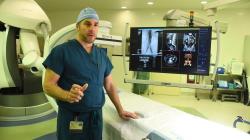UM BWMC Turns Major Surgery for Silent Killer Into Needle Pricks

UM BWMC chief of vascular surgery Dr. Justin Nelms
By: Selene San Felice
Capital/Gazette
Robert Krysiak had no idea he had an aneurysm, let alone three abdominal aortic aneurysms on the cusp of rupturing.
When his doctor told Krysiak he’d need surgery right away, he had no idea the procedure would be so easy.
Krysiak is one of the latest patients to have a procedure done at Baltimore Washington Medical Center’s new endovascular surgery center.
In the last year, the Glen Burnie hospital has transitioned from cutting patients like Krysiak open to doing simpler procedures with just a couple needle pricks.
Officials at the hospital, part of the University of Maryland Medical System, said it is the first in the mid-Atlantic area to use the robotic imaging system that simplified the surgery.
“That has been the cool paradigm shift since my training,” said Dr. Justin Nelms, chief of vascular surgery.
Nelms used to perform open surgeries that would take four to five hours with a week of recovery in the hospital, plus rehab if necessary and a lot of post-op pain.
With the new procedure, he’s only doing surgery for about an hour or two and patients only need one or two days of recovery time. Plus, he said the risk of heart attack, stroke, renal failure, respiratory failure, bleeding and infection are much lower.
For Krysiak’s endovascular aortic aneurysm repair, Nelms used the hospital’s new robotic imaging system to re-line Krysiak’s aorta with a large, branched stent called an endograft. Once deployed, the endograft relieves the aneurysms from systemic pressure, stopping them from rupturing.
Traditionally, this would be a large open operation with a major abdominal incision and groin incisions. After a couple needle pricks and two days of recovery, Krysiak said he was back to normal.
“It’s like he never had surgery after that first day,” said Krysiak’s wife, Connie.
Krysiak’s doctor found his aneurysms at his yearly checkup, which he said he almost skipped since he didn’t feel sick. Most aneurysms are asymptomatic until they rupture, but once they do they can be deadly. Half of all rupture patients never make it into the hospital. Only a quarter end up surviving.
The most vulnerable demographic for aneurysms is people in their 60s and 70s, especially men. Smoking is also the biggest risk factor, Nelms said. Patients only need one screening in their lifetimes, but Nelms recommends multiple screenings for higher risk patients.
The Krysiaks are now making sure each of their five sons get tested.
“It’s very important that people don’t let it go,” Connie Krysiak said. “You’re tempted to wait another year, but you have to keep up with appointments.”
Copyright 2019 – Capital/Gazette
